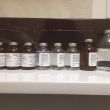Admittedly, the promise of a hangover cure is what initially lured me to Intravenous Vitamin Therapy. As someone susceptible to incapacitation the day after, not the night of drinking, receiving a glut of vitamins seemed a healthier option than the ritualistic bacon, egg, and cheese, persistent nausea, and, at minimum, seven scattered naps—even if it meant voluntarily sticking a needle in my arm.
Unfortunately, all hope of a realistic hangover cure was destroyed when I discovered that most medical spas that'll hook you up to a drip at will only operate during the business week. (I'll add that I am not in the habit of being overly intoxicated on a weekday.) Maybe just a dry run, I thought, scheduling an appointment on a weekday afternoon—I was intrigued enough by the concept that post-drunkeness need not inhibit my exploration.Vitamins are always a good thing, right?
A few days and a 30-minute train ride later, I find myself in a medical spa uptown, signing a consent form and filling out a vague medical history form (my primary care physician’s information wasn’t asked for, strangely enough). On a separate sheet, the benefits of the treatment and ingredients in the Myers' Cocktail are explained, along with a list of any potential side effects—including anxiety and anaphylactic allergic reactions. Later, a nurse tells me clients usually feel an immediate burst of energy following the IV. I look forward to being a more vivacious version of myself (at the time, I was suffering a headache from drinking too much caffeine—needless to say, I was grumpy).
I'm led into the treatment room, which is furnished like a doctor's office but lit like a spa. The medical spa’s sole RN pulls vials of vitamins out of a black lacquered Armand de Brignac “Ace of Spades” Magnum Champagne box. She fills an IV bag with the vitamin concoction, ties a tourniquet above my left elbow, and instructs me to squeeze a stress ball that looks and feels like an avocado. “You have good veins,” she tells me while disinfecting the area and then administering the IV. Then, she dims the lights and instructs me to relax.
Easier said than done. For 20 minutes, I lay on a reclined examination bed with a left arm that feels like a fishing weight. My arm throbs from time to time. Out of fear of screwing something up, I avoid making any movements while the IV protrudes from my forearm, except for my fingers to combat intermittent tingling. I wouldn't call it painful, but I certainly wouldn't call it comfortable. My headache was temporarily alleviated, though, so there's that.
When I left the medical spa and returned downtown, I felt strange. Beyond the new vitamins floating around my blood stream, I was just confused: Why would a place—a “medical” spa, rather—give an otherwise perfectly healthy human a treatment they don’t medically need simply because they are willing to pay for it? Though the consent form I signed stated one of the guidelines for participating in the treatment included understanding that “intravenous vitamin therapy is being used only if the doctor deems it therapeutically necessary in your treatment,” I never met either of two doctors who run the medical spa. They weren't mentioned by the RN either.
“Oh Alexis, why would you do that?” was all my mother—also a registered nurse—could say at first when I mentioned the experience. “I bet they didn’t even check your vitamin levels to start.” (She was right.) When I reached out to the communications department of a large clinical, research, and teaching medical hospital in Manhattan, asking for a professional opinion on IV therapy, they declined to contribute. All indicating that my decision to voluntarily partake in IV vitamin therapy was very poor judgment. Potentially dangerous considering all invasive procedures—no matter how seemingly benign—carry risks.
In the last few days, my mind's been wandering back to that champagne box filled with vials—quite literally vitamins and “health” encased in wealth and prestige. An ironic, literal packaging of how we culturally approach and consume wellness today: not as necessary or even beneficial, but instead a commodity bridging us closer to the otherwise aspirational and unattainable.
As for all future hangovers: they’re inevitable. At least now in comparison, one bacon, egg, and cheese doesn’t sound so bad.
—Alexis Cheung
Photos by Alexis Cheung.






